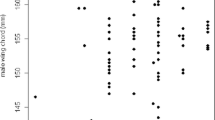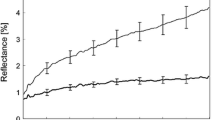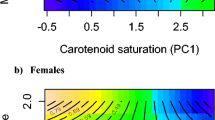Summary
-
1.
Interspecies pairings between captiveCarduelis carduelis, Clitoris ckloris and domestic canaries result in a roughly similar output of eggs per pair, and probably in a comparable number of offspring, as pure species pairs. The interspecies differences in plumage, voice and display patterns thus seem not to be of crucial importance when pairing is forced. It is suggested that in nature these differences are primarily significant at the time of pair formation.
-
2.
The plumage characters of goldfinch × greenfinch hybrids are examined. Most characters are variable and more or less intermediate between the parent species, but in some cases the condition found in one parent is dominant.
Similar content being viewed by others
References
Danforth, C. H. (1950). Evolution and plumage traits in pheasant hybrids.Evolution,4, 301–5.
Haig Thomas, R. (1915). White collar mendelizing in hybrid pheasants.Proc. Zool. Soc., Lond., pp. 279-84.
Hinde, R. A. (1953). The conflict between drives in the courtship and copulation of the chaffinch (Fringilla coelebs).Behaviour,5, 1–31.
Hinde, R. A. (1955). A comparative study of the behaviour of certain finches.Ibis,97, 706–45;98, 1-23.
Hinde, R. A. (1956). The behaviour of certain carduelineF 1 inter-species hybrids.Behaviour (in the Press).
Huxley, J. S. (1942).Evolution: the Modern Synthesis. London: Allen and Unwin.
Lerner, I. M. (1954).Genetic Homeostasis. London and Edinburgh: Oliver and Boyd.
Lorenz, K. (1935). Der Kumpan in der Umwelt des Vogels.J Orn., Lpz.,83, 137–213, 289-413.
Lorenz, K. (1941). Vergleichende Bewegungstudien an Anatinen.J. Orn., Lpz.,89, 194–293.
Mayar, E. (1942).Systematics and the Origin of Species. Columbia University Press.
Meise, W. (1936).über Artentstehung durch Kreuzung in der Vogelwelt.Biol. Zbl. 56, 590–604.
Miller, A. H. (1941). Speciation in the avian genusJunco.Univ. Calif. Publ. Zool. 44, 173–434.
Morris, D. (1954). The reproductive behaviour of the zebra finch (Poephila guttata).Behaviour,6. 217–322.
Parkes, K. C. (1951). The genetics of the golden-winged × blue-winged warbler complex.Wilson Bull. 63. 545.
Phillips, J. C. (1915). Experimental studies of hybridization among ducks and pheasants.J.Exp. Zool. 18, 69–143.
Phillips, J. C. (1921). A further report of species crosses in birds.Genetics,6, 366–83.
Sibley, C. G. (1950). Species formation in the red-eyed towhees of Mexico.Univ. Calif, Publ. Zool. 50 109–94.
Tlnbergen, N. (1948). Social releasers and the experimental method required for their study.Wilson Bull. 60, 6–52.
Tinbergen, N. (1954). The origin and evolution of courtship and threat display. InEvolution as a Process, edited byHuxley, J., Hardy, A. C. &Ford, E. B. London: Allen and Unwin.
Author information
Authors and Affiliations
Rights and permissions
About this article
Cite this article
Hinde, R.A. Breeding success in cardueline interspecies pairs, and an examination of the hybrids’ plumage. J Genet 54, 304–310 (1956). https://doi.org/10.1007/BF02982785
Received:
Issue Date:
DOI: https://doi.org/10.1007/BF02982785




